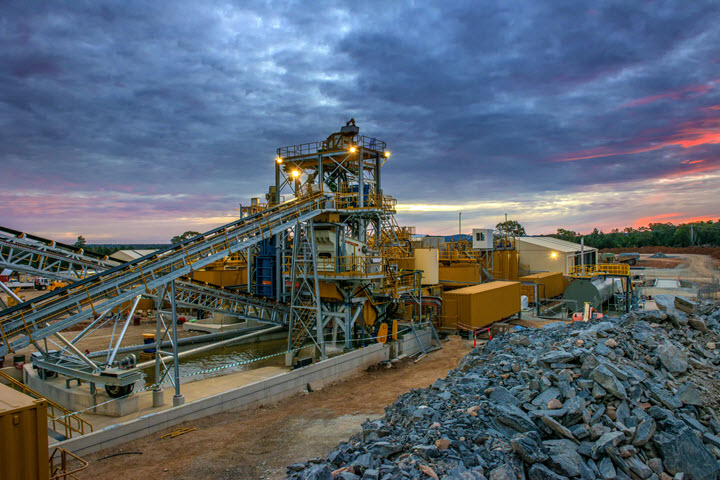Overview
Haul trucks transport the ore from open pits or underground operations to processing operations. Some ores may be stockpiled for later processing. Rock that is not economical to mine is stored in waste rock storage areas. The grade and type of ore determine the processing method used. Additionally, the geochemical makeup of the ore, including its hardness, sulfur content, carbon content and other minerals found within, impact the cost and methods used to extract gold.
Processing Methods
Depending on the ore, we process it using the following methods: We feed ore into a series of crushers and grinding mills to reduce the size of the ore particles and expose the mineral. Water is also added, which turns the ore into a slurry. We send this slurry to leaching tanks, where we add a weak cyanide solution to the slurry, which leaches gold and silver into the solution. This process removes up to 93 percent of the gold and 70 percent of the silver from the ore. Carbon granules are then added to the solution. The gold attaches to the carbon and is pulled from the solution. We then “strip” the gold from the carbon by washing it with a caustic cyanide solution. The carbon is later recycled. Next, we pump the gold-bearing solution through electro-winning cells, which extract metals from the solution using an electrical current.
After gold has been processed, the leftover waste material is called tailings. Tailings contain small amounts of cyanide and other hazardous chemicals, so they must be disposed of in an environmentally safe way. The tailings are stored in tailings dams, which are lined with impermeable layers. While the cyanide levels in the dam are safe, steps are taken to keep wildlife away from the dams.
Over time, the chemicals break down and the solids settle to the bottom so that the water can be returned to the plant to be used in processing. We then smelt the gold, which melts it in a furnace at about 1,202 degrees F. From there, the liquid gold is poured into molds, creating doré bars. Doré bars are unrefined gold bullion bars containing anywhere from 60 to 95 percent gold. We finally send the bars to a refinery for further processing into pure gold.
Alternative Ore Processing
We use alternative gold recovery methods in some processing plants to accommodate different ore characteristics or other requirements. For example, ore that has a high level of sulfide minerals or carbon (or both) is called refractory ore. Refractory ore resists normal processing methods as the high sulfide minerals trap gold particles, making it difficult for the cyanide to reach the gold and leach it.
Heating
To leach gold from refractory ore, it must be subjected to high temperature, high pressure and/or oxygen. Newmont treats refractory ore in two ways: by using an autoclave or a roaster.
An autoclave is used before leaching occurs. First, the slurry is heated and fed into an autoclave, where high-pressure steam, water and oxygen are applied to oxidize the sulfide material by a chemical reaction. The slurry is then cooled and sent back into the process to be leached.
An alternative to an autoclave is a roaster, a very high temperature oven that is often used instead of an autoclave if the ore to process contains a large amount of organic carbon. Roasting uses heat and air to burn the organic carbon into fuel and to burn the sulfur off ore, which we heat to 932 to 1,202 degrees F.
Heap Leaching
In heap leaching, we dump crushed ore into piles called heaps, to which we apply a weak cyanide solution, using drip feeders. The gold dissolves into the cyanide solution. The entire heap leach area is lined with heavy duty liners to ensure no solution leaks into the environment. Next, we collect the gold-cyanide solution in ditches and ponds, and then transport it to a recovery plant.
Flotation
Flotation is a method of separating minerals depending on their ability to attach to air bubbles.
Flotation can be used for a number of materials by adjusting the chemicals. At Mirael Gold Fields, it is used for other minerals recovery and, in a very limited number of cases, for gold processing.
We introduce air bubbles to the slurry while it is in small tanks, called flotation cells. We add some chemicals to the slurry to assist the process. The desired minerals stick to the bubbles and rise to the top, resulting in froth. The froth overflows from the tank, and is removed and sent to the next step in processing.
Gravity Circuit
A gravity circuit recovers coarse gold before it is leached. Gravity circuits use the same principles as gold panning: coarse gold is heavier than other material and will settle to the bottom so that it can be removed (gold is 19.3 times heavier than an equal volume of water).



